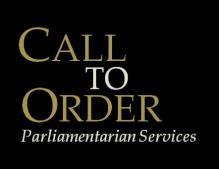In Mr. Smith Goes to Washington, the naïve Mr. Smith yields the Senate floor out of courtesy to a colleague, In doing so he loses his ability to debate on his legislation to prevent graft and corruption, Mr. Smith learned the hard way about the importance of knowing procedural rules. Officers and members of boards and and associations need to know the rules of order to achieve their goals and help their enterprises succeed. Our expertise includes:
- Meeting and Session Governance Services
- Presiding Officer Services
- Delegate Convention or Assembly Services
- Strategic Procedural Planning Services
- Bylaw Drafting, Review, and Revision Services
- Written Opinions Services
- Training Programs
On 6 November 2013 the Executive Council of New Hampshire took a vote on whether to adopt a motion to approve the guarantee of a note issued to a Thomas More College in Merrimack, NH by First Colebrook Bank. The vote was 2 yeas, 1 nay, 1 abstention and one member was absent. The Governor, who was the presiding officer, declared the vote had failed. The Governor believed the rule for passage required a majority of those present. That is, 4 members were present, and, therefore, 3 votes were needed for passage. She was wrong and here’s why.
Most of us understand a majority as more than half. Half of what? The answer to this question yields great confusion. Some believe it’s half of those members present as the Governor of NH did while others believe it’s half of the votes cast.
Unfortunately belief has nothing to do with it as most bylaws specify what the number of votes are needed for passage. Most manuals of parliamentary procedure such as Robert’s Rules of Newly Revised specify what a majority is. When unqualified, a majority is more than half of the votes cast. Most all manuals agree that abstentions or blanks ought to be excluded from the total count. Manuals of parliamentary procedure differ on whether to include illegal votes in the total. The task of developing examples to illustrate the impact of including or excluding abstentions or illegal votes is simple. The important point is to know what the rule is.
In the case of the New Hampshire Executive Council, the manual of parliamentary procedure is the most recent version of Mason’s Manual of Legislative Procedure, 2010. It states that “a majority of the legal votes cast, a quorum being present, is sufficient to carry a proposition…. Members present but not voting are disregarded in determining whether an action carried. Mason’s Section 510. Therefore, the total number of votes was 3 yielding a majority of two votes. Since the vote was 2 yeas, 1 nay, the motion carried and The Thomas More College got its loan guarantee!
The Council meet in a subsequent meeting and corrected itself to declare that the motion had passed.

© 2011-2014 Call to Order Parlimentarian Service
When is a majority a majority? Even the Governor of New Hampshire can get it wrong!


